James Gibbs' Other Chain Stitch Sewing Machine

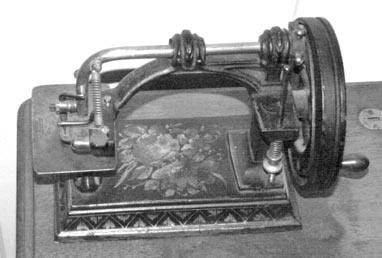
Fig. 4:
The Gibbs chainstitch machine
(Carter Bays Collection)
James E. A. Gibbs of Mill Point, Pocahontas County, Virginia is famous for his invention of the rotary hook chainstitch sewing machine. He is the 'Gibbs' of Willcox & Gibbs.
The earliest sewing machines made either the lockstitch (Howe, Singer, Wheeler & Wilson) or the two-thread chain stitch (Grover & Baker). The story goes that James Gibbs saw an advertisement for a Grover & Baker sewing machine in a magazine. He had not seen an actual sewing machine and, looking at the picture in the advertisement, it did not occur to him that there was an underthread, so he set about trying to devise a single thread sewing machine. He came up with several ideas, some of which he patented, for single thread machines making a chainstitch.
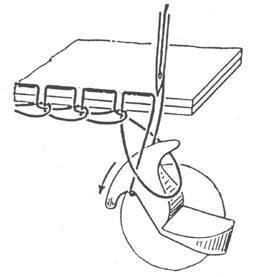
Fig. 1:
Gibbs' rotating hook chainstitch mechanism
His greatest invention by far was a chainstitch made by a rotating hook below the clothplate (Fig. 1). The hook caught the loop of thread cast off by the needle as it started to move upwards, retained it as it rotated and held it open so that, the next time the needle descended, the needle picked up the loop from the previous stitch. He patented the idea on June 2nd 1857 (US patent 17427) and it went into production in the form we all know it, the following year (US patent 21129 of August 10th 1858) (Fig. 2). From then on, the Willcox & Gibbs chainstitch machine remained pre-eminent and in production until the 1930s. Every collector has one or more. The machine was widely cloned by other manufacturers and even Singer used the same rotary hook mechanism on the class 24, class 30 and the class 20 toy machine. It was the only really successful single thread chainstitch mechanism.
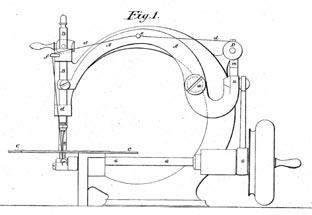
Fig. 2:
Gibbs's patent (21129) for the W & G single thread chain stitch machine we all know
At least one other of his chainstitch ideas got into small scale production as the Gibbs Sewing Machine. This was based on his patent of October 12th 1858 (US patent 21751). Quite why he got this crazy machine off the ground a year after the successful launch of the rotary hook machine with Charles H. Willcox, we will probably never know. Figure 3 shows the patent drawing of the machine and Fig. 4 shows a surviving machine. The construction appears very simple, so how does it make its chainstitch. The handwheel has a single groove milled in it to oscillate the shaft D (Fig. 3). The machine makes two stitches for each revolution of the wheel and it does not matter in which direction the wheel is turned. As the arm D is oscillated, the needle both makes the stitch and feeds the cloth through the machine.

Fig. 3:
Gibbs' patent (21751) for his other single thread chainstitch machine
The needle is held on an arm A which is pivoted on the end of arm D (Fig. 5). A coil spring around the pivot tries to hold the needle arm A in the position shown in Fig. 6d; in contact and the serrations on the lower surface are angled so that it with the stitch length adjusting screw. An extension of the frame carries pivots for the presser foot B and the guide bar C. The presser foot is held in contact with the cloth by a spring. It has a long slot in which the needle works is 'easy' to pull cloth from right to left (Fig. 6) and difficult to push cloth from left to right.

Fig. 5:
Detail of the Gibbs chainstitch machine
(Carter Bays Collection)
Figure 6a shows the machine at one extremity of its travel, with arm D about to start moving in the direction of the arrow. Arm A is deflected to maximum extent by the needle rolling on guide bar C. In Fig. 6b, arm D has rotated so that the needle passes through the cloth and picks up (we hope) the loop left on the hook H (Fig. 7) from the last stitch. Arm D rotates further and (Fig. 6c) the needle rolls on guide bar C so that arm A pivots to become vertical, removing the previous loop off the hook H. Further rotation of arm D (Fig. 6d) causes the needle to leave guide the bar C and the hook H picks up a new loop cast off by the needle. As the needle assembly assembly rotates, it feeds (i.e. 'pulls') the cloth under the presser foot away from the operator.
For the return stroke, the rotation of arm D in the opposite sense returns the needle to the start (Fig. 6a) above the cloth. As the needle assembly rotates again it must not 'push' the cloth back (reverse the feed) so the presser foot friction must exceed the force necessary to twist A about the end of D. Everything depends on the little hook H below the clothplate being in the correct place and the needle not bending as it feeds the cloth. Hook H is provided with screw adjustment (very critical) and a guide G is provided to keep the needle straight.
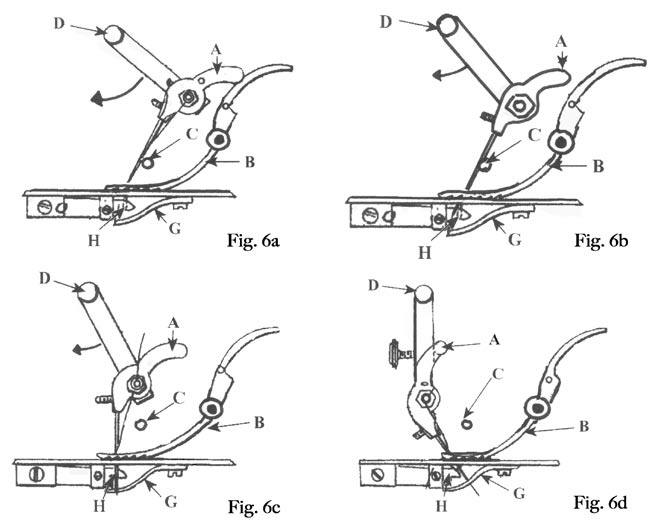
Fig. 6:
Diagrams to show the formation of the stitch
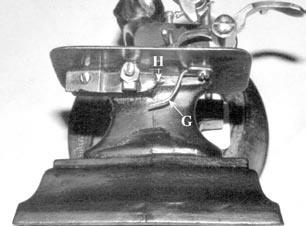
Fig. 7:
The hook H and guide G below the cloth plate
When we remember that dropping a loop in this sort of chain stitch leads to the seam unravelling, it is hard to imagine anyone sewing long seams on this machine. I suspect one was forever fiddling with the adjustments to the little hook H and needle guide G and the various springs. I do not know who made the machines but serial numbers run above 10000, though it is unlikely so many were made.
One excellent design feature is a integral table clamp hinged into the base (Fig. 8). I have never seen such a device before. It is even adjustable for tables of different thickness!

Fig. 8:
Underside view of Gibbs machine showing the integral table clamp.





